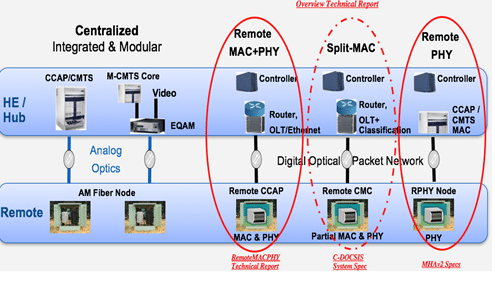Evolving to Distributed Access Architectures
 By Chris Bastian, Senior Vice President/CTO, SCTE/ISBE
By Chris Bastian, Senior Vice President/CTO, SCTE/ISBE
The cable operator’s access network is undergoing an evolutionary shift. The “traditional” HFC access network placed the Cable Modem Termination System (CMTS) in the hub or headend, connected via fiber to the fiber node in the outside plant, which then converted the RF signals to coax for the “last mile” to the customer’s home. This centralized architecture is depicted on the left side of the diagram below, with both integrated and modular variants.
The Distributed Access Architecture (DAA) as specified by CableLabs is enjoying widespread support throughout the cable operator and vendor community. DAA shifts where the various functions are performed in the network. First off, let’s define what those network functions are:
Media Access Control (MAC) layer—responsible for controlling how devices in a network gain access to a medium and permission to transmit data (IEEE)
Physical (PHY) layer—responsible for the transmission and reception of data between the access terminal and the access network; supports electrical or mechanical interfaces connecting to the physical medium (IEEE)

Source: CableLabs® Distributed CCAP Architecture
The three dominant DAA options, depicted on the right side of the above diagram, are:
- Remote MAC + PHY: moves the entire CMTS out of the hub site and into the fiber node.
- Split-MAC: moves the PHY layer, and a portion of the MAC layer, out of the hub site and into the fiber node. The remaining portion of the MAC layer remains in the hub site, or possibly migrates northbound into the data center.
- Remote PHY: moves only the PHY layer into the fiber node. The MAC layer remains in the hub site, or possibly migrates northbound into the data center.
Benefits and Challenges of DAA
Each of the DAA options has its varying degrees of benefits and challenges. They have the following in common:
Benefits:
- Reducing space, power, and HVAC demand on the hub sites.
- Moving PHY layer closer to the home, resulting in better network performance—less noise, higher modulation, more capacity, and higher speeds.
- Lower operational expenses associated with alignment, maintenance, and improved network visibility due to the distributed intelligence.
- Distributing functionality if efficiently aligned to a path toward virtualization and integration with alternative last-mile access technologies.
Challenges:
- Increasing the complexity of electronics that will reside in a harsher fiber node environment. Environmental testing is key.
- Interoperability testing of the elements remaining in the hub with those migrated to the fiber node is crucial. These elements could be from different vendors.
- Timing/synchronization, as elements that were once co-located could now be split hundreds of miles apart (although typically they are much closer).
- Ability to perform software and maintenance upgrades that were previously in a hub environment but will now be in an outdoor plant environment.
- Ease of remote maintenance, as there are orders of magnitude more node locations than hub locations.
There are cable operators and vendors testing and field trialing all of these DAA options. When I talk with people across the industry, I am hearing a consistent theme: There is no longer a one-size-fits-all solution. Different network operators have different selection criteria, and all of these architectures, including the traditional centralized architecture, have their proponents.